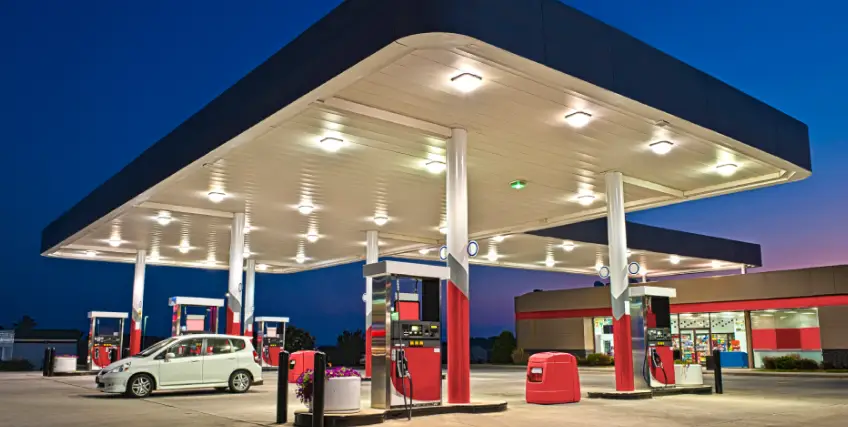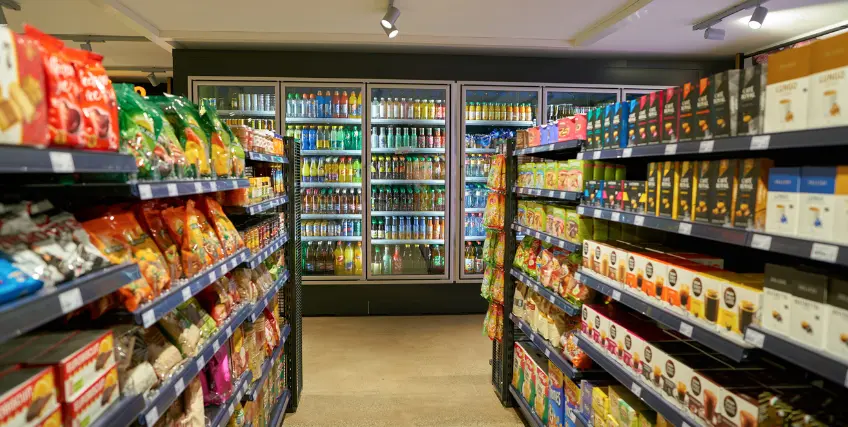Rising Stars in a Tight Credit Market: Gas Stations & Convenience Stores
February 14, 2025 | Last Updated on: February 17, 2025

Gas stations with convenience stores have long been an enduring staple in the retail landscape, offering both necessity and convenience to consumers on the go. The appeal of this business model lies not only in its dual revenue streams but also in its adaptability to changing market trends. For small business owners, owning a gas station with a convenience store can be a rewarding venture. This article aims to guide you through the key steps involved in purchasing, financing, and operating such a business successfully, helping you navigate the complexities and harness the opportunities this industry presents.
Understanding Gas Stations with Convenience Stores
The business model of gas stations with convenience stores is uniquely beneficial due to its dual revenue streams: fuel sales and retail operations. Fuel sales attract a steady flow of customers, often leading to impulse purchases inside the store.
Popular brands of convenience petrol stations and convenience store chains include Buc-ee's, Circle K, Quiktrip, Sheetz, Wawa, and 7-Eleven Inc. Additional providers include Sunoco, Speedway, Royal Farms, Racetrac, and Kwik Trip. While some service station owners prefer to remain independent, signing on with an established brand can lend instant credibility to your community.
Whether you're located in Florida, Texas, Michigan, Pennsylvania, or anywhere else, location is key. No matter which city you're in, the success of this model heavily depends on where your store is located. Service stations at busy intersections or near highways tend to attract more customers. Additionally, understanding customer demographics allows owners to tailor their inventory to meet local needs, ensuring customer satisfaction and repeat business.
Industry Trends
In recent years, several trends have shaped the gas station and convenience store industry. Eco-friendly fuel options are gaining popularity as consumers become more environmentally conscious, prompting stations to consider offering alternative fuels in addition to premium gas, regular gasoline, and diesel fuel.
Technology integration, such as mobile payment systems and app-based loyalty programs, enhances customer experience and operational efficiency. Meanwhile, evolving consumer preferences demand a shift towards healthier food options and premium products in-store. For example, a deli within your food mart offering fresh sandwiches and sides can be a good alternative to fast food. Staying abreast of these trends is crucial for small business owners looking to adapt their operational strategies to maintain a competitive edge.
How to Purchase a Gas Station with a Convenience Store
If you're considering purchasing a gas station with a convenience store, you must perform research on potential locations, local markets, and easy gas convenience station brands.
Perform Research and Market Analysis
Conducting a thorough market analysis is the first step in purchasing a gas station with a convenience store. Understand the local market dynamics, including customer behavior and competitor presence. Identify locations for the closest convenience store gas station with high traffic volume and minimal competition to maximize profitability. Analyzing these factors will provide insights into the potential success of your venture.
If you're unsure how to conduct this research, consider buying an industry report. These reports offer insights and benchmarking to write your business plan and monitor your performance against peers once your store opens.
Finding the Right Opportunity
Finding the right gas station to purchase requires diligent research. Explore listings on broker websites, industry networks, and auction platforms. Evaluate each opportunity based on financial health, traffic volume, and brand reputation. Consider gas stations with established customer bases and strong community ties, as these factors contribute to long-term success.
Due Diligence Process
Due diligence is a critical phase in the purchasing process. Investigate financial records, legal obligations, and existing contracts to assess the station's health. Environmental assessments are essential to identify potential liabilities, such as underground fuel tank leaks, ensuring compliance with regulations and protecting your investment.
Financing the Purchase
Once you've decided to purchase a gas station with a convenience store, where will the money come from, and how much do you need? Entrepreneurs often use a combination of personal assets and loans to finance the purchase of an existing business or to open a new store from scratch.
Understanding the Costs
Purchasing a gas station involves several costs, including real estate, inventory, and equipment. Additionally, hidden costs such as renovations and regulatory fees should be considered. Understanding these expenses upfront allows for better financial planning and reduces the risk of unexpected financial burdens.
Financing Options
There are several financing options available for purchasing a gas station with a convenience store. Traditional bank loans are common, though they require a strong credit profile and a detailed business plan. SBA loans offer favorable terms for small businesses, though they involve a rigorous application process. Alternatively, seller financing can be negotiated, providing flexibility but potentially at higher interest rates.
Here are a few financing options to consider when purchasing a convenience store in a gas station:
- Personal assets: Many entrepreneurs save money to start a new business to minimize the debt they need to carry. The money could be in a bank account, investments, or alternative assets like crypto.
- Home equity: Tapping your home equity can provide easy cash at a low interest rate. However, be careful when putting your home at risk. If your business fails, you will lose not only your income but also your home.
- SBA loan: SBA loans backed by the Federal government encourage small business owners to buy or open new businesses. These loans are offered by traditional banks, credit unions, and online lenders and typically have easier qualification criteria than other business loans.
- Traditional bank loans: Banks usually lend to established businesses or entrepreneurs with a solid track record of success. You may qualify for a term loan to buy or expand your business or a business line of credit to use your short-term financing needs.
- Online lenders: Online lenders can provide access to cash for borrowers who cannot qualify for traditional loans. While the interest rates and fees may be higher, these lenders can be a good option when you have bad credit, hard-to-verify income, or simply need cash quickly.
Preparing Your Finances
A strong financial profile is essential for securing financing to buy a gas station with a convenience store. Maintain a healthy credit score and prepare a comprehensive business plan outlining your operational strategy and financial projections. This will not only appeal to lenders but also serve as a roadmap for your business's future success.
Borrowing Money to Run the Store
Operational Costs
Running a gas station with a convenience store involves ongoing expenses such as staff wages, inventory restocking, and maintenance. Effective budgeting and cash flow management are crucial to ensuring financial stability. Monitor expenses closely and make adjustments as needed to maintain profitability.
Securing Working Capital
Securing working capital is vital for day-to-day operations. Lines of credit offer flexibility in managing cash flow, while business credit cards can provide immediate funds for smaller expenses. Use these tools wisely to avoid excessive debt and maintain financial health.
Alternative Funding Sources
Consider alternative funding sources to supplement your capital needs. Crowdfunding and community investment can provide additional financial support, especially in tight-knit communities. Additionally, explore grants and incentives available for small businesses, particularly those located in rural or underserved areas.
Managing and Growing Your Business
Staffing and Training
Hiring reliable staff and implementing effective training programs are key to successful operations. Focus on customer service excellence, as satisfied customers are more likely to return and recommend your store to others.
Marketing and Customer Engagement
Develop a marketing strategy that targets your desired customer base. Utilize loyalty programs and promotions to attract and retain customers. Engage with your community through social media and local events to build a strong brand presence.
Adapting to Market Changes
Regularly review and adjust your business strategies to adapt to market changes. Embrace technology and innovation, such as contactless payments and self-service kiosks, to enhance customer experience and streamline operations.
The Bottom Line
Owning and operating a gas station with a convenience store presents numerous opportunities for small business owners. You can build a successful and profitable gasoline station by understanding the business model, conducting thorough research, securing appropriate financing, and implementing effective management strategies. Stay informed about industry trends and remain adaptable to changes, ensuring your business remains competitive in the ever-evolving retail landscape.
Frequently Asked Questions (FAQs)
Do Gas Stations Count as Convenience Stores?
While there are many gas stations with convenience stores, there are still quite a few of these remain standalone businesses. Brands like 7-Eleven Inc. operate some locations as standalone general stores, while others also include a gasoline station.
How Much Does It Cost to Build a Gas Station with a Convenience Store?
The cost of building a gas station with a convenience store varies based on location, local rules and regulations, the size of your store, and which brand you partner with. The typical range to build a gas station is $250,000 to $1.1 million. Startup costs can extend up to $2 million depending on the size of your general store and the additional offerings available, such as an automated car wash.
What Gas Station Chain Has the Most Stores?
The three largest gas stations in the U.S. are Shell, Exxon Mobil and BP. Shell has the most locations, with 13,410 gas stations. Although brands like Sunoco, Speedway, and RaceTrac aren’t in the top 10, they are still viable brands.
Do Convenience Stores Sell Gas?
Not all convenience stores sell gas, but many general stores offer gas to increase revenue. There are more than 152,000 convenience stores in the U.S., and approximately 120,000 sell gasoline and diesel fuel. With so many locations, it is estimated that 80% of gas purchased in the U.S. is sold at a convenience store.
Frequent searches leading to this page
Related Articles
The Fuel for Success: Innovative Ways to Finance Your Gas Station Convenience Store
February 17, 2025
Rising Stars in a Tight Credit Market: Gas Stations & Convenience Stores
February 17, 2025
Is Business Financing the Right Choice for Your Convenience Store Expansion?
February 17, 2025




